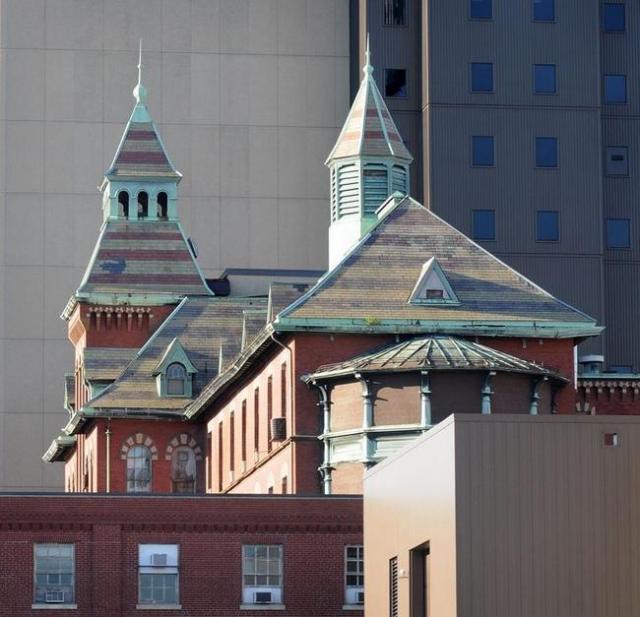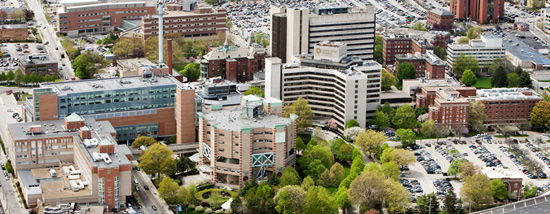It appears that the days are numbered for the sad, lonely final relic of the old Rhode Island Hospital. The Providence Journal’s Patrick Anderson reports in “Rhode Island Hospital plans to raze 115-year-old Southwest Pavilion, last remaining building from original complex,” that officials of Lifespan, the hospital conglomerate that owns RIH, believe that renovation is not an option. For now, at least, there are no plans to replace it.
The building is surrounded by ugly medical structures that scream of a sterile bottom line as the highest priority of the healing profession. I venerate the Southwest Pavilion, but maybe this is one of those rare examples of a lovely old building that should be demolished. “Put it out of its misery” might be the gentle cry of its death knell.
The medical complex is a cluster of ugly modernist structures just beyond the Route 195 corridor. Its architecture speaks as clearly as modern architecture can, voicing bad news for people who are ill and people who want to cure them. But that voice has been ringing in our ears for decades as modern medicine, for all its technological miracles, leans away from its own “first, do no harm” principles.
Only the Southwest Pavilion, designed by Stone Carpenter & Willson and opened in 1900, speaks in the soft, level-headed tones that hark back to the day when doctors made house calls. In fact, the Victorian building looks like a house for doctors, nurses and patients. It stands alone against the will of the medical community to make hospitals symbolize our worst fears for the future of health care in Rhode Island and in America.
Thankfully the Providence Preservation Society’s director, Brent Runyon, has spoken out against the demolition plan. He told the Journal’s reporter that
We think it is incredibly short-sighted and unfair to the community because that building is the last remaining building of the original complex. It had a lot of firsts and the significance within the state is high. They continue to mistreat it and cause it to deteriorate and now say it costs too much to restore.
That is a deplorable strategy of long standing here and elsewhere. The assessment that the pavilion has no useful future arises from a lack of imagination that speaks poorly of Rhode Island’s medical community. And I doubt that its structure truly cannot find a use amid a sprawling modern medical facility. The firm hired to assess the Southwest Pavilion’s future – Durkee, Brown, Viveiros & Werenfels Architects – knew what they were being paid to find, I suspect, and they were determined to earn their money.
Even as science increasingly urges hospital designers to bring beauty to bear on behalf of healing, the medical complex is a cluster of modernist clunkers that pays little heed to how it looks. And believe it or not, its unappealing hodgepodge is the aesthetic now planned for the I-195 corridor, the so-called Knowledge District intended to house medical technology firms and research labs in the area vacated by the relocation to the south of Route 195.
The medical complex is a visible symbol of how to use architecture to kill “the vision of an appealing, vibrant urban neighborhood.” Those were the words used to express current hopes for the I-195 Redevelopment District by its new director, Peter McNally, in this week’s Providence Business News. But copying the medical complex is a poor strategy for achieving that result. Alas, it is a strategy that the commission appears to support.
The Southwest Pavilion plays a lovely melody on a violin whose soft chords may still be heard, if you listen closely, among the clattering garage band that surrounds it. I hope it can be saved. But I am not holding my breath.





Pingback: R.I. Hospital, a place for healing | Architecture Here and There
Pingback: Silence for S.W. Pavilion | Architecture Here and There
Pingback: Respite for an old hospital? | Architecture Here and There
This makes me heart hurt. I won’t go to see their doctors though.
LikeLike
I have heard, Deb, though not confirmed that the Southwest Pavilion has received at least a temporary reprieve, with RIH having been rebuffed by the city, at least for now. I don’t believe that the hospital needs the city’s approval to demolish, however, so what’s next is anybody’s guess.
LikeLiked by 1 person
I will keep my fingers crossed! I know these situations are challenging for everyone involved.
LikeLike
Demolition by neglect is included in the Providence Historic District Commission
Design Guidelines for the Industrial & Commercial Buildings District. I was not able to find out if the Souhtwest Pavilion is included though it obviously has historical and architectural value. The guidelines allow the City to repair such buildings if the owner does not and then place a lien against the property to cover the cost of the work. Isn’t it about time the City provided the “teeth” the Commission does not possess?
LikeLiked by 1 person
Go for it, City, sez I! (Not holding breath.)
LikeLike
best example of what can be done with a crumbling relic is the Richardson Olmsted Complex in Buffalo (formerly HH Richardson-designed Buffalo State Asylum for the Insane – how’s that for a moniker!??!). now being turned into hotel & conference center – and the Buffalo Architecture Center (http://www.richardson-olmsted.com/). very cool!
LikeLike
Just visit the Boston Medical Center to see how well they conserved the original Victorian fabric of that vital, state of the art institution. Rhode Island Hospital has no excuse.
LikeLike
death by willful neglect – an all too common malady that has been around forever. no one is looking for a vaccine, I guess.
LikeLike
First job for the first biotech firm on the 195 corridor!
LikeLike
They’re fools.
LikeLike